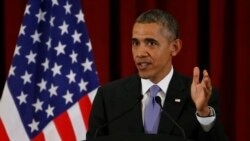“This is my fifth trip to Asia as President, and I plan to be back again later this year,” U.S. President Barack Obama said recently at a Young Southeast Asian Leaders Initiative Town Hall meeting in Kuala Lumpur, Malaysia. “Because . . . I made a deliberate and strategic decision . . . that America will play a larger, more comprehensive role in this region’s future.”
From America’s earliest years, when the first President, George Washington, sent a trade mission to China, through last year, when the aircraft carrier that bears his name, the George Washington, helped with typhoon relief in the Philippines, America has always had a history with Asia.
“And we’ve got a future with Asia,” President Obama said, “because [Asia is] home to more than half of humanity, Asia will largely define the contours of the century ahead -- whether . . . marked by conflict or cooperation; by human suffering or human progress. This is why America has refocused our attention on the vast potential of the Asia Pacific region.”
“We have been moving forward on our rebalance to [Asia] by opening ties of commerce and negotiating [the Trans-Pacific Partnership]; by increasing our defense and educational exchange cooperation, and modernizing our alliances; by participating fully in regional institutions like the East Asia Summit; building deeper partnerships with emerging powers like Indonesia, [Malaysia] and Vietnam,” he said.
“Our strategy is more than just security alliances or trade agreements,” he said. “It’s also about building genuine relationships between the peoples of Asia and the peoples of the United States, especially young people.”
“We’re launching a new Young Southeast Asian Leaders Initiative to increase and enhance America’s engagement with young people across the region,” he continued.
“Together, we want to make the Asia Pacific more prosperous . . . Together, we want to make the Asia Pacific cleaner and more secure . . . Together, we can make this world more just.” President Obama said. “We need to build together, in partnership, with all the nations and peoples of the region, especially young people. That vision is within our reach if we’re willing to work for it.”
From America’s earliest years, when the first President, George Washington, sent a trade mission to China, through last year, when the aircraft carrier that bears his name, the George Washington, helped with typhoon relief in the Philippines, America has always had a history with Asia.
“And we’ve got a future with Asia,” President Obama said, “because [Asia is] home to more than half of humanity, Asia will largely define the contours of the century ahead -- whether . . . marked by conflict or cooperation; by human suffering or human progress. This is why America has refocused our attention on the vast potential of the Asia Pacific region.”
“We have been moving forward on our rebalance to [Asia] by opening ties of commerce and negotiating [the Trans-Pacific Partnership]; by increasing our defense and educational exchange cooperation, and modernizing our alliances; by participating fully in regional institutions like the East Asia Summit; building deeper partnerships with emerging powers like Indonesia, [Malaysia] and Vietnam,” he said.
“Our strategy is more than just security alliances or trade agreements,” he said. “It’s also about building genuine relationships between the peoples of Asia and the peoples of the United States, especially young people.”
“We’re launching a new Young Southeast Asian Leaders Initiative to increase and enhance America’s engagement with young people across the region,” he continued.
“Together, we want to make the Asia Pacific more prosperous . . . Together, we want to make the Asia Pacific cleaner and more secure . . . Together, we can make this world more just.” President Obama said. “We need to build together, in partnership, with all the nations and peoples of the region, especially young people. That vision is within our reach if we’re willing to work for it.”

















